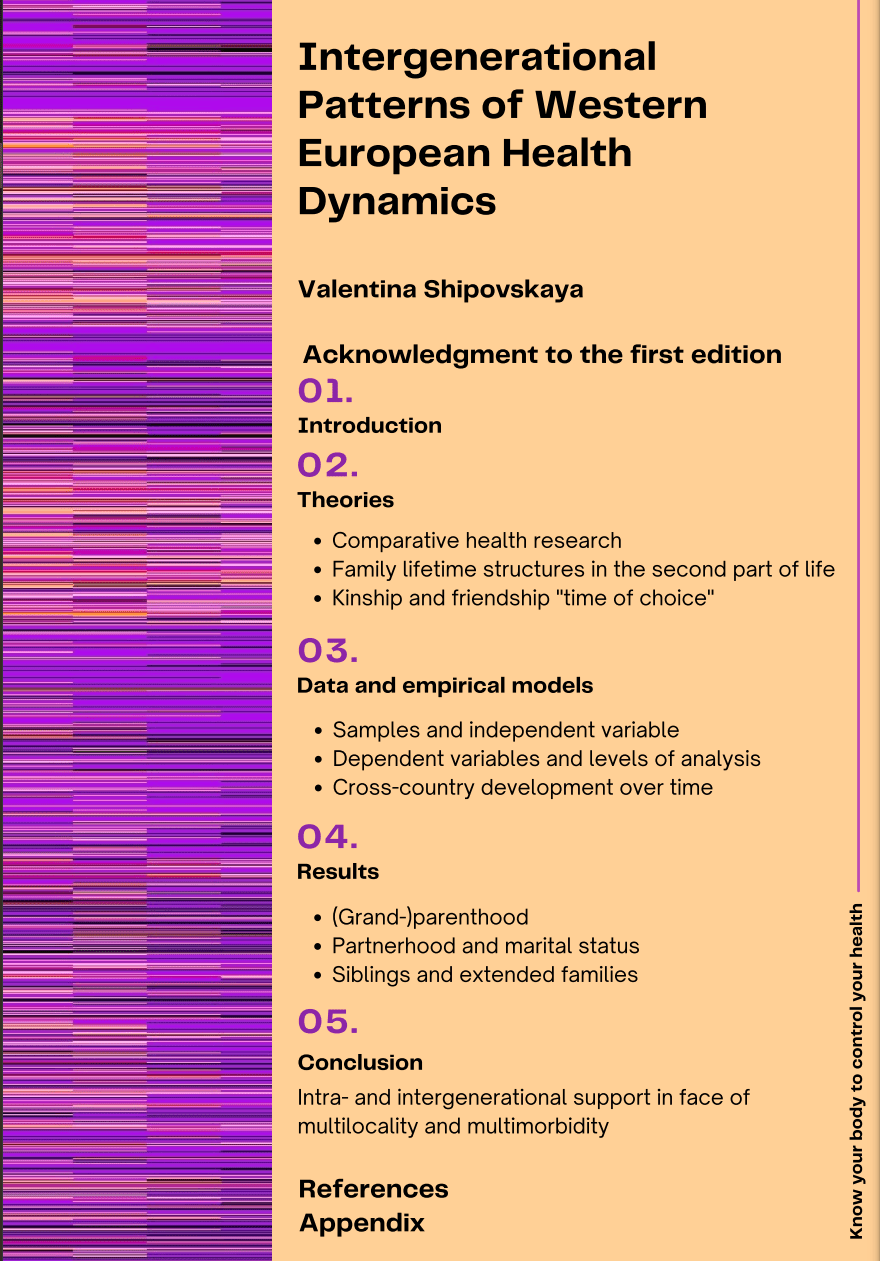
The demographic patterns of mature family dynamics
In memory of the great Russian-Ukrainian demographer Anatoliy G. Vishnevskiy (1 April 1935 – 15 January 2021)
“[...] [D]emographic techniques can be used to enhance our understanding of the gendered implications of population aging, particularly as they relate to policy research and public debate” (Ophir, Polos 2020: 197)
„[…M]arriage and cohabitation continue to have distinct meanings, with marriage representing a stronger level of commitment, and cohabitation a means to cope with the new reality of relationship uncertainty“ (Perelli-Harris, Mynarska, Berrington, Berghammer, Evans, Isupova, Keizer, Klärner, Lappegård, Vignoli 2014: 1046)
„As adult children are a major source of intergenerational support, childless elders risk a lack of support. [...] They are more often engaged in voluntary activities and hold strong linkages with next-of-kin relatives, neighbours, professionals and friends. [...] Their informal caregivers are often the extended family, friends and neighbours. [...] In countries where few social services are offered or support is unknown by the public, childless elders may risk a lack of care and social isolation“ (Heylen, Mortelmans, Knaeps 2020: 32-33)
„[...] informants suggested that cohabitation was not only associated with self-fulfillment and individualization, but also the part of the life course when it was appropriate to try out multiple partners“ (Perelli-Harris, Mynarska, Berrington, Berghammer, Evans, Isupova, Keizer, Klärner, Lappegård, Vignoli 2014: 1055)
„Gender and gender equity represent an important challenge for fertility research. Gender shapes reproductive strategies, [...] power relations within the household [...] Historically, traditional family arrangements have correlated with higher numbers of children. [...][A]t the same time the provision of child care from kin diminished and parents were increasingly removed from the family sphere, intensifying the stress of women`s double burden of combining wage and domestic work [...]“ (Miettinen, Basten, Rotkirch 2011: 470)
„Countries with the lowest prevalence of second unions – Lithuania, Poland, Italy, Spain, and Belgium – all share a relatively strong influence of the Catholic Church. Our results highlight the different pathways to a stepfamily in Europe, and show that in most European countries a considerable proportion of women enter a stepfamily in childbearing ages, which needs to be considered in studies on fertility“ (Prskawetz, Vikat, Philipov, Engelhardt 2003: 139)
„Childless women with traditional gender values have high personal fertility ideals but, interestingly, low intensions to actually have children. Women with intermediate gender attitudes plan most strongly to have a child and also to have many children“ (Miettinen, Basten, Rotkirch 2011: 480)
„Several comparisons of fertility and houshold formation patterns between European countries have been presented in the literature. Many of these studies have used the framework of the second demographic transition. [...] In North and West European countries, with Sweden and Denmark as forerunners, postponement of marriage and childbearing and increasing prevalence of consensual unions have been observed first. Southern Europe followed this demographic pattern with some time lag while in Eastern Europe this demographic change did not take place untel the 1990s.“ (Prskawetz, Vikat, Philipov, Engelhardt 2003: 109).
“Children of divorced parents get their marriage dissolved significantly more often than do otherwise comparable children of non-divorced parents. This intergenerational transmission of divorce risk is significant in several industrialized societies [...]. These societies differ from one another in many respects, one of which is family policy. These differences might have an impact not only on the short-term effects of parental divorce on children but also on the long-term consequences” (Engelhardt, Trappe, Dronkers 2002: 296)
“At a marriage duration of ten years, the risk of divorce for children whose parents were divorced is more than twice as high as for children who grew up in families with both parents, a widowed parent, or an unknown parent” (Engelhardt, Trappe, Dronkers 2002: 308) (*“[...] `the Family` as a set of informal rules which organize the positive and negative interdependencies that exist among a large number of family members” (Widmer 2010: 3))
“A higher age at marriage is clearly associated with higher marital quality, as factors such as the partners’ maturity, vulnerability to rapid changes during (late) adolescence, competence to take on marital roles, partner search time, and financial resources vary depending on their age at marriage [...]” (Wagner 2020: 49)
„The ongoing discussion on gender equity and fertility involves many different views and approaches [...][P]revious studies have found that both traditional and egalitarian gender attitudes can contribute to higher fertility. A clear role division between spouses, whether egalitarian or polarised, may improve their `team work` and facilitate everyday coping “ (Miettinen, Basten, Rotkirch 2011: 484)
“A particularly promising development in comparative scholarship has come with the elaboration of the concept of “social policy regimes”, which offers a way to analyze the qualitative variation across national systems [...] as institutionalized patterns in welfare state provision which establish systematic relations between the state and social structures of conflict, domination, and accommodation. Such patterns refer to the terms and conditions under which claims may be made on the resources of the state, and reciprocally, the terms and conditions of economic, social, and political obligation to the state” (Orloff: 1996: 25)
“[...] selection may play an important role in shaping marital health trajectories [...] Despite an increased use of sophisticated methodology such as FE panel regression in more recent studies, the existing body of research may still contain selection bias in terms of individuals` premarital health trends, potentially overestimating the protective marriage effect” (Mikucka, Becker, Wolf 2021: 18)
“These personal histories contain valuable information to understand the situation of a person today. Just like a patient`s medical history is essential for a doctor making a diagnosis. Personal histories can be a valuable part of quantitative research. [...] Most aspects of our life can be imagined in a dynamic way, as a series of transitions from tone stage to another, reflecting both developmental and social changes we go through as we age” (Vanhoutte, Wahrendorf, Prattley 2018: 2)
“Using holistic trajectories, as sequence analysis does, allows us to establish what a typical order of succession of states [...] In sum, there are strong reasons to use sequence analysis when examining the social aspects of health that concern the importance of personal history for the present, the power of holistic trajectories to uncover social processes [...]” (Vanhoutte, Wahrendorf, Prattley 2018: 5)
“The readability of an index plot, and its utility for detecting patterns, can be improved by sorting the plotted sequences according to either the first or last recorded state or value of some other attributes of interest” (Vanhoutte, Wahrendorf, Prattley 2018: 8)
“[...] visual inspection can give us a feel of how sequences differ from each other. Quantifying their properties allows an even more precise and in-depth comparison, as well as enabling the use of descriptive summary statistics of sequences [...] Examining these properties of sequences by different genders, social groups, or cohorts can help to answer a number of research questions such as [...] the differentiation and destandardization of the life course” (Vanhoutte, Wahrendorf, Prattley 2018: 11)
“Rather than building a moralistic discourse regarding the decline of the Family [... we try – V. S. …], by the use of empirical research, to understand the patterns that made the new kind of family experiences” (Widmer 2010: 1)
“In relation to reproduction male and female are psychically polarized (sexual difference); they are thought of in binary terms which are naturalized as two parents. In non-reproductive relationships, the term gender is not binary. Gender is not a binary construction. In other words, sexual difference is a mark of polarity, and gender is the continuum [...]” (Mitchell 2003: 221)
“[...] family configurations are embedded in demographic constraints, related to partnerships, fertility options, divorces, migrations, social mobility and deaths. In that sense, family configurations are not highly personalized expressions of lifestyles or individual preferences, but [...] the results of series of events and transitions that have happened in life courses of family members” (Widmer 2010: 32)
“Conflicts develop with people who matter [...] The concept of ambivalence permits a deeper understanding of the roots of family conflicts by emphasizing the contradictions that many individuals develop while being interdependent with family members [...] Family conflicts should not be regarded as signs that the Family is on the verge of collapse, but rather as an expression of the vitality of family interdependencies” (Widmer 2010 : 74)
“It is widely acknowledged that the ageing of societies involves much more than just changing demographic patterns. [...] Social security systems re-distribute economic resources e.g. between men and women, the childless and parents, the employed and those who provide (unpaid) family care” (Motel-Klingebiel, Arber 2006: 7)
“[...] Being sandwiched – having parents and children – is not necessarily a situation of role-overload and overburden” (Künemund 2006: 26)
“Nevertheless, the interrelations between family policy and socialization, stress, economic deprivation, and stigmatization are not yet fully understood” (Engelhardt, Trappe, Dronkers 2002: 317)
Focus: "Sandwich" Generations in Western Europe
The proportion of childless and childfree men and women of reproductive age has increased and is expected to rise even further in future generations. It has been the main aim of this study to investigate whether this development, paralleled by decreasing union stability, should give a reason for concern regarding health and well-being in later life.
It seems worthwhile to investigate further issues of complementarity and substitution between different partnership models from a cross-nationally comparative perspective with more details of individuals` increasingly complex life histories and the relationship between the sequencing and timing of family events (such as early or late entries into (grand-)parenthood).
Informal care is expected to postpone the transition toward residential care. Intergenerational family structures became more complex due to socio-demographic and cultural changes. How do changing intergenerational family structures affect intergenerational solidarity within Europe? Who are the older adults at risk of weak intergenerational ties?
This interdisciplinary study uses descriptive elements of sequence analysis and fixed-effects regression based on the high-dimensional balanced panel data from the four waves of the Survey of Health, Ageing and Retirement in Europe (SHARE-project.org, waves 1, 2, 4, 5) released between 2004 and 2013.
My study uses intergenerational, life course, and country-comparative approaches to find out: (1) how sex differences (biomarker “grip strength” as a functional health indicator ) vary in different welfare regimes; (2) what are the patterns of functional health dynamics for women and men, and (3) how intergenerational and family transitions are related to particular health outcomes. The independent variables used in this analysis refer to (1) the family ties, socioeconomic and health status on the micro-level, and (2) the generosity of welfare context on the macro level.

